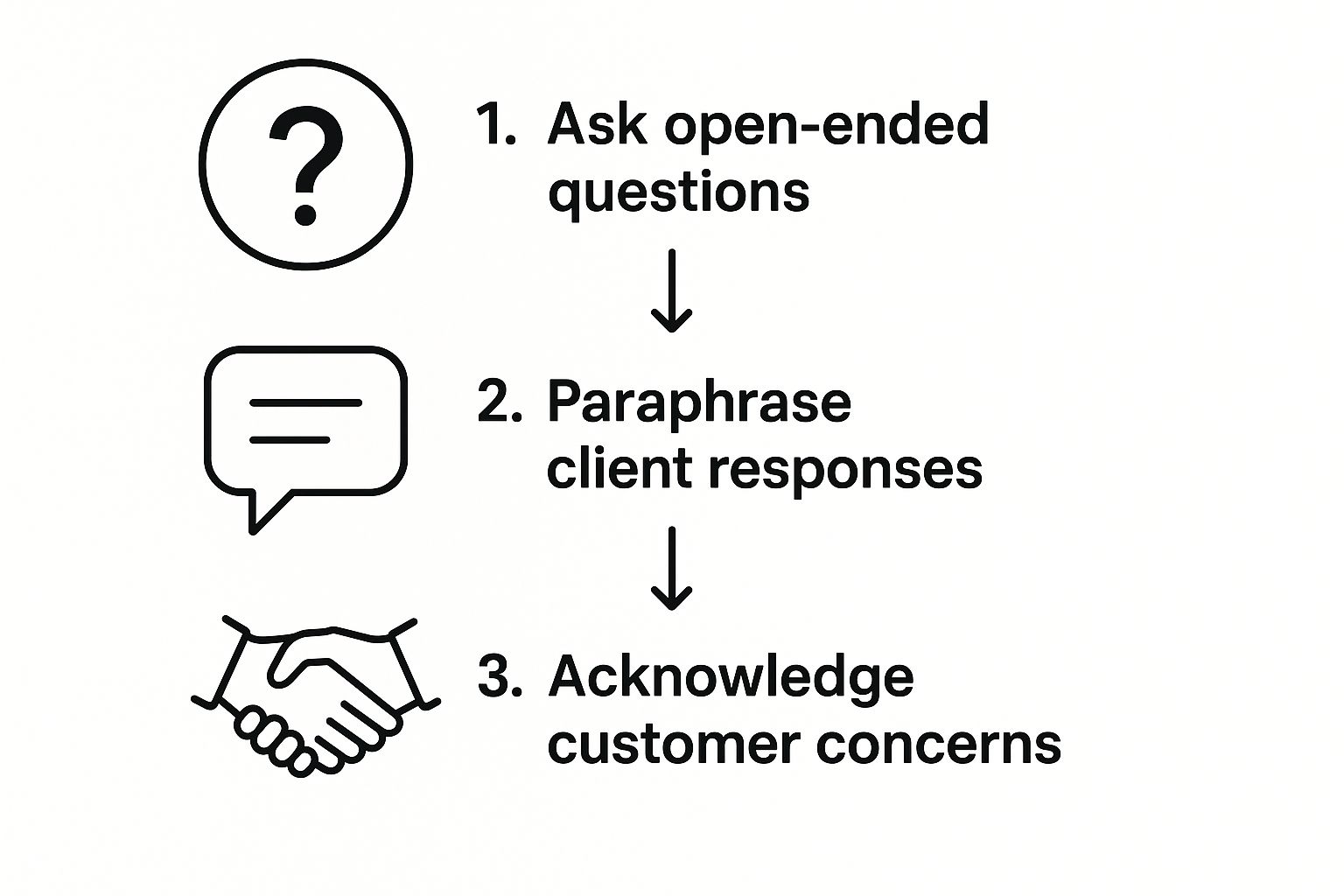The key to handling sales objections isn't some secret script or magic phrase. It starts with a fundamental shift in your thinking: stop seeing objections as a "no" and start treating them as a request for more information.
When a prospect pushes back, they're not shutting the door. They're engaging. They're telling you what's on their mind, giving you a golden opportunity to understand their real concerns.
Reframe Objections: From Roadblocks to Opportunities

The moment a prospect raises a concern, the real sales conversation has just begun. If you see their objection as a wall, you'll naturally become defensive, and the whole dynamic turns into a confrontation. Nobody wins there.
But if you see it as an opening? The entire approach changes. It stops being about winning an argument and starts being about solving a problem together.
This all comes down to two skills every great salesperson has mastered: active listening and genuine empathy. Before you even think about your response, your first job is to just listen. What’s the real issue? Often, the thing they say first—like price—is just a smokescreen for a deeper fear, like a lack of trust in your company or worries about a painful implementation process.
Listen First, Then Empathize
Active listening isn't just waiting for your turn to talk. It's about getting to the heart of their words, emotion, and intent. Sales objections are a normal, healthy part of any deal. They aren't final decisions; they're conversation starters.
Try simple techniques to show you're really hearing them:
- Summarize their point: "So, if I'm understanding you correctly, the main concern is…"
- Acknowledge their feeling: "I can definitely see why that would be a worry for you."
This approach immediately builds trust and moves you out of the "pushy salesperson" box and into the "trusted advisor" role. For more on this dynamic, the team at OnePageCRM.com has some great insights.
By treating an objection as a request for clarity, you disarm the prospect's defensive posture. This empathetic response opens the door for a real conversation, allowing you to uncover their core needs and demonstrate how your solution is the perfect fit.
Ultimately, this mindset is the foundation that makes every other technique effective. Without it, even the best scripts feel hollow. When you truly learn to welcome objections, you start building stronger relationships. And that's how you close more deals.
A Flexible Framework to Deconstruct Any Objection
Trying to memorize dozens of scripts for every single objection is a losing game. Not only is it impossible, but it makes you sound robotic and rehearsed. A much better approach is to have a simple, reliable framework you can adapt to any conversation. This lets you handle whatever comes your way with confidence.
The best framework I've ever used is a simple three-part process, and the magic is in its order: listen, clarify, and then—and only then—respond. So many sales reps stumble because they hear an objection and immediately jump on the defensive, making assumptions about what the prospect really means. Trust me, a price objection is rarely just about the price. It's usually a smokescreen for a deeper concern about ROI, trust, or the pain of implementation.
Listen Without Interrupting
When a prospect starts raising a concern, your gut reaction is probably to jump in and correct them. Don't do it. Seriously, bite your tongue. Interrupting sends a clear signal that you care more about making your point than understanding theirs.
Let them get everything out, even if it ends with an awkward silence. This simple act of patience accomplishes two critical things. First, it shows respect, which is fundamental to building the rapport you need to have a real conversation. Second, it gives you the full story so you're not just reacting to a fragment of the problem.
A prospect's first objection is often just the tip of the iceberg. The real, more significant concern—the one that will actually kill the deal—is usually hidden just beneath the surface. True listening helps you find it.
Clarify to Uncover the Root Cause
Okay, so you've listened patiently. Your next move isn't to launch into your counter-argument. It's to dig deeper. Most objections are pretty vague at first, and it's your job to get to the heart of the matter. You need to be sure you understand what they're actually saying and probe for the why behind their words.
This is the clarification stage, and it’s where you turn a potential conflict into a collaboration.

As you can see, understanding starts with asking smart questions and validating their perspective. For a closer look at structuring these conversations, it’s worth exploring different sales qualification frameworks to guide your questioning.
A simple paraphrase like, "So, if I'm hearing you correctly, the main worry is how this would integrate with your team's current system?" does wonders. It confirms you're on the same page and invites them to share more, bringing you one step closer to solving the real problem.
Your Playbook for the Most Common Sales Objections

While every conversation feels different, you’ll quickly notice that most sales objections boil down to just a handful of core issues. The real pros aren't just winging it; they have a plan.
This isn't about memorizing lines like an actor. It’s about understanding what’s really being said and having a solid strategy to guide the conversation forward. You’ll find that nearly every piece of pushback you get will fall into one of four buckets: price, timing, authority, or need.
Let’s break down how to handle each one.
Tackling Price and Budget Objections
When a prospect hits you with, "It's too expensive," your first instinct might be to talk discounts. Don't. A price objection is almost never about the price tag itself—it’s a value objection in disguise.
They're really saying, "I don't see how the value we get is worth the cost you're asking for." Your job is to close that gap. The best way to do this is to get curious and pivot the conversation back to the return on their investment.
Here's how that might sound:
"I appreciate you sharing that, and you're right to make sure this is a smart financial decision. To help me understand, could you tell me which part of the proposal felt out of line with the results you're looking to get?"
This opens the door to a real conversation about value, not a negotiation about price.
Navigating Timing and Urgency Issues
Ah, the classic stall: "Now isn't a good time," or "Give me a call next quarter." Sometimes it's a legitimate scheduling issue, but more often, it’s a mask for hesitation. It means they don't feel the pain of their problem acutely enough to act now.
Your goal isn’t to apply pressure. It’s to gently highlight the cost of inaction. What pain will they still be dealing with in three or six months if they do nothing?
You can do this in a couple of ways:
- Tie it back to their goals: "That's fair. You had mentioned wanting to fix [Problem X] to hit your Q4 goals. If we push this to next quarter, how does that affect your timeline for achieving that?"
- Introduce natural scarcity (only if it's real): "I only mention it because our current implementation queue has an opening in two weeks, but after that, we’re booked for the next six. If this is a priority, I want to make sure you can get a spot."
Handling Authority and Decision-Maker Roadblocks
Hearing "I need to run this by my boss" is a clear sign you might not be talking to the person with the final say. The worst thing you can do is try to go around them. That’s a fast way to kill the deal and burn a bridge.
Instead, your mission is to turn your contact into an internal champion. Equip them to sell your solution on your behalf when you're not in the room.
Offer to help them prepare for that meeting. A great way to frame this is to position yourself as their partner in getting the green light.
Pro Tip: Try this line: "That makes perfect sense. To help you prepare for that conversation, what are the key metrics and outcomes your boss is going to care about most? Let's make sure you have everything you need to make a strong case."
This shifts the dynamic entirely. You're not a pushy salesperson; you're a strategic partner helping them solve a problem and look good doing it.
A Quick Guide to Common Objections
To help you prepare, here’s a quick-reference table with some of the most frequent objections you'll hear and a solid way to start your response. Think of these not as scripts, but as conversational springboards.
Common Sales Objections and How to Respond
| Objection Type | What They Say | Effective Response Starter |
|---|---|---|
| Price | "Your price is too high." | "I hear you. Can you help me understand what you were budgeting for this?" |
| Competition | "We're already working with [Competitor]." | "That's great, they're a solid company. What do you like most about working with them?" |
| Timing | "Call me back in six months." | "I can definitely do that. What's set to change in six months?" |
| Authority | "I'm not the right person to talk to." | "Thanks for letting me know. Who would be the best person to discuss this with?" |
| Need | "We don't have a need for this right now." | "I understand. Could you tell me a bit about how you're currently handling [Problem Area]?" |
Having these starting points in your back pocket can make all the difference, turning a potential dead-end into a productive, deal-closing conversation.
How to Navigate Objections About Competitors

It’s a classic moment in any sales cycle: "Thanks, but we're already working with [Competitor X]." This isn't the end of the road, but it's a critical juncture. Your next move determines whether the conversation continues or shuts down for good.
The absolute worst thing you can do? Start bad-mouthing their current provider. It's a natural impulse, but it's a rookie mistake that almost always backfires.
When you attack a competitor, you're indirectly criticizing the prospect's decision-making. This immediately puts them on the defensive, forcing them to justify their choice. Instead of opening a door, you've just built a wall.
A much better approach is to start with validation. Acknowledge their choice with a bit of respect. Something as simple as, "That's great to hear, they're a solid company," can completely disarm them. It shows you respect their judgment and shifts the dynamic from a confrontation to a conversation.
Uncover Pain Points with Strategic Questions
Once you’ve built that initial rapport, your real work begins: gently probing for dissatisfaction. You can’t just come out and ask, "So, what do you hate about them?" You have to be more nuanced.
Your goal is to use insightful, open-ended questions that get the prospect to identify the weaknesses in their current setup all on their own.
Here are a few ways to frame these questions:
- "That's great they're helping you with [Task A]. I'm curious, how are they supporting your strategy for [Task B]?"
- "What was the main driver for choosing them initially, and how has that played out over time?"
- "If you could wave a magic wand and change one thing about your current solution, what would it be?"
When a prospect voices a complaint about their current provider, they are essentially selling themselves on the need for a change. Your job is to simply guide them to that realization.
This isn't just theory; the data backs it up. An analysis of over 300 million sales calls revealed that about 7.9% of all objections are related to an existing solution. The most successful reps consistently avoid criticism and instead use smart questions to find the cracks. You can see more of the findings on sales objections at Gong.com.
By getting a clear picture of what makes them tick—and what their current provider is missing—you can position your solution perfectly. For a deeper dive into this, check out our guide on how to create buyer personas. This strategy frames you not as a replacement, but as the superior alternative that solves the specific problems they just told you they have.
Turn Your Skills into Instinct Through Practice
Knowing the right words to say is one thing. Delivering them with confidence when a prospect is pushing back is a completely different ballgame. The only way to bridge that gap between theory and real-world performance is practice. And lots of it.
Think of it like building muscle memory. An athlete doesn't think about every tiny movement; they just react. That’s what you’re aiming for—to make your responses so ingrained that they become instinct.
Role-Play Until It's Second Nature
One of the best ways I've seen teams sharpen their skills is through consistent role-playing. It’s your chance to test out new responses in a safe space, get honest feedback from your peers, and iron out the kinks before you're on a live call.
When you've rehearsed a response a dozen times, it stops sounding like a script and starts sounding like you. It just flows naturally because you've put in the reps.
Keep a Personal "Objection Journal"
This is a simple but incredibly powerful habit: keep a log of every objection you hear. I tell every salesperson I train to do this. Don't just jot down the objection itself; write down the context, what you said, and how it landed.
This journal becomes your personal playbook. Over time, you'll start to:
- See the same objections pop up again and again.
- Tweak and perfect your answers based on what actually works.
- Share your findings with the rest of the team so everyone gets better.
The point of all this practice isn't to become a robot who just recites lines. It's to build the confidence to listen intently and adapt on the fly, knowing you have a solid foundation to fall back on.
This stuff really moves the needle. Organizations that commit to ongoing sales training see a 20% increase in sales results compared to those that don’t. You can read more about the impact of sales training from Jordan Stupar's blog. It’s a huge part of any solid sales enablement strategy. For more great ideas on this, check out these 9 sales enablement best practices you should know.
Frequently Asked Questions About Handling Objections
Okay, so you have the framework. But what happens when things get chaotic on a live call? It's one thing to handle a single, clean objection, but prospects rarely make it that easy.
Sometimes they'll throw three or four at you all at once. It’s a classic move, whether intentional or not, and it can leave you flustered.
The trick is to isolate and prioritize. Don't try to tackle everything at once. Take a breath and calmly ask, "That's helpful, thank you. Of everything you just mentioned, what's the single biggest thing standing in the way for you?"
This does two things. First, it stops you from getting steamrolled. Second, it shows the prospect you're actually listening and trying to understand their core issue. More often than not, if you solve the main problem, the smaller ones just seem to fade away.
What If the Deal Is Just a Bad Fit?
This is a tough one, but it's a crucial part of being a true sales professional. Not every deal is a good deal. Learning to spot a bad fit and having the confidence to walk away is just as vital as closing.
If a prospect’s needs are fundamentally out of sync with your solution, or their budget is completely locked with zero wiggle room, pushing for a sale is a massive mistake. You're not helping them, and you're not helping your company. All you're doing is setting up a future headache—an unhappy customer, a support team nightmare, and a potential hit to your reputation.
A respectful "no" is always better than a forced "yes." Politely acknowledging that it's not a good match saves everyone's time and energy. It shows confidence and positions you as a consultant, not just a seller.
And what about after the call? We've all been there. You hang up after a particularly rough conversation and your confidence is shot. The best thing you can do is take five minutes to debrief. What went well? What could you have done differently? Jot it down, learn from it, and then move on.
Don't let one tough conversation poison your entire day or your next call. Shake it off and get back out there.
Ready to put these skills to the test with a pipeline full of high-quality leads? The Nordic Lead Database gives you access to the most comprehensive list of companies and key decision-makers in the Nordics.
Find your next great conversation at https://nordicleaddatabase.com.
